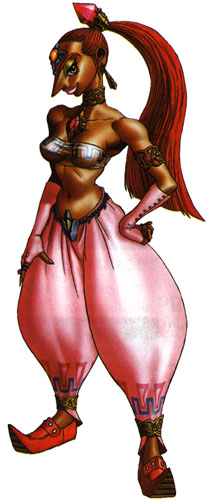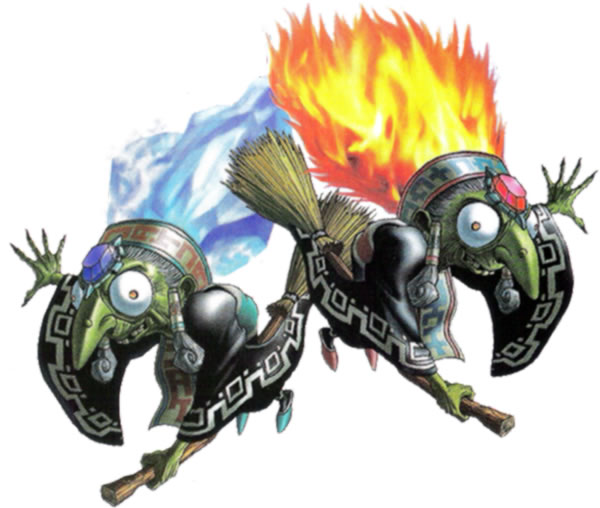
The reliance of magical universes on… well, magical explanations for incredible phenomena can be dissatisfying. But moreover, it can hinder fun conversational avenues.
Captious and Inquisitive Eccentric: How does that guy turn into a giant pig monster?
Obligatory Correspondent for Illustrative Purposes: Magic.
Eccentric: Oh. So, does he possess genetically-determined traits that enable him to relegate and channel so-called “magical” energies otherwise unavailable to the average person in order to capacitate the metamorphosis, which would be otherwise energetically unfeasible?
Obligatory Correspondent: No, he has the Triforce of Power, which is magical.
Eccentric: Oh. Well, couldn’t we interpret the label “Triforce of Power” as a genetic marker which gave rise to the abilities mentioned before? We can still stipulate that magic exists, but modify its implementation in the universe. Now, instead of being an excuse not to think of an interesting explanation for things, it can be a critical thinking exercise!
Obligatory Correspondent with Waning Patience: No. The Triforce is a magical object. Originally, its Wisdom, Power, and Courage subunits separate when someone with unequal distribution of those characteristics touches it. That person is endowed with the Triforce unit he or she embodies best, and the other two thirds endow their respective paragons elsewhere in the universe.

Eccentric: Ah, so the Triforce is an analytical haptic device that excludes gaseous molecules from evaluations of intent. Presumably it needs to come in contact with a solid system capable of sustaining emergent intentionality and temperament if we are to indulge the inexact “Wisdom, Power, and Courage” paradigm. It must either identify such systems in its vicinity using scanning technology or by taking tissues samples for DNA analysis of genetic disposition for wisdom, power, and courage. However, given that the Triforce exists in a society in which the cannon represents advanced technology, the question arises as to the Triforce’s origins. Who made it?
Increasingly Agitated Obligatory Correspondent: It wasn’t made. After the goddesses Nayru, Din, and Farore made the universe, they merged into the Triforce. It contains their essences.
Eccentric: Hold on a second, we just did a little semantic dimensional leap here. Without going off on a tangent about how vague the word “essence” is, consider the following. In order for the goddesses to exist prior to the universe they created, there has to be an overarching plane of existence that abides their presence, even conceptually. Doesn’t this just all seem like a metaphor for the design team behind The Legend of Zelda? They are creators existing outside of the universe that they create, after all. They even fuse their minds in a manner analogous to the goddesses’ merging. By extension, this makes the Triforce a symbol of the game itself existing inside the game’s universe. It turns out that this is an exercise in conceptual self-reference!
Obligatory Correspondent: NO METAGAMING. IT’S MAGIC.
See? Dissatisfying. Obviously, The Legend of Zelda series takes place in a magical universe. It has magical answers to pertinent questions. But wouldn’t it be fun to establish the rules of that magic using basic reasoning and scientific inquiry? And not in a D&D sense, where quantitative modifiers are assigned to arbitrarily-defined events and traits, but in the all-encompassing sense of something like the Theory of Evolution with regard to biology. Less Wrong‘s Harry Potter and the Methods of Rationality is a sirloin example of Übernerd reinterpretation of magically-characterized fiction. There’s no common pragmatism utility to said reinterpretation, but by Merlin’s beard is it fun. And again, a most glowing kowtow to exercises in critical thinking.
So, bearing in mind this overlong exposition, let’s talk about sex, baby. That is: let’s talk about reproduction in the Gerudo race.

Pictured on the left is Nabooru from Ocarina of Time, a prototypical example of a Gerudo: bronze-skinned, golden-eyed, crimson-haired, and leptorrhine. Sure, all the Gerudos look the same because it’s economical to reuse character models in video games, but let’s keep our arguments non-meta for the time being.
The Legend of Zelda mythos strongly suggests an association of the Gerudo race with the Triforce of Power and its affiliated concepts: fire, earth, strength, and so on. For example, Din, the divine essence embodied in the Triforce of Power, is implied to be incarnated in Oracle of Seasons as–you guessed it–the Oracle of Seasons, who happens to look almost identical to a typical Gerudo. Also, Ganondorf, a Gerudo, consistently acquires or possesses the Triforce of Power throughout the games in which he appears.
According to The Legend of Zelda games, Gerudos kick it semi-Amazon style; their race is wholly female with the exception of a single male born once every 100 years. This male becomes king by default. Assuming that “every 100 years” translates more practically to “once an average Gerudo lifespan”, there are several non-deus-ex-machina considerations of the Gerudo’s gender distribution:
Gerudos may reproduce via haplodiploidy or ZW sex-determination means that contains sufficient overlap with the sex-determining factors of other Hyruleans to produce viable offspring. In some of these conditions, we assume that the Gossip Stone from Ocarina of Time that proclaims, “They say that Gerudos sometimes come to Hyrule Castle Town to look for boyfriends” implies interbreeding of Gerudos with male Hyruleans. Continuing logically, we have the following options:
In a haplodiploid situation, female Gerudos are born diploid and males, haploid. In essence, all unfertilized eggs would develop into males. Given that its unlikely that Gerudo females conceive with a partner every time they ovulate, Gerudo populations would contain far more males. Of course, the estrous cycle of Gerudos may not be monthly; if they have exceptionally lengthy ovulation cycles or perhaps only a single release of eggs over the course of their lifetimes, the drive to reproduce prior to and around those ovulation periods will be subsequently enormous. If it is enormous to the extent that every Gerudo in a male-less population acquires a mate to fertilize her eggs with the exception of one, then in that cycle of reproduction, all offspring with will be female with the exception of one, producing the alleged “one male every 100 years”. However, this condition requires that all Gerudos reproduce at approximately the same time. Additionally, there are these considerations:
1. If the females are mating with Hyrulean males to procreate, the likelihood of only a single Gerudo in a generation failing to reproduce are slim. In order to assure this, social hierarchies surrounding mating selection would have to be imposed on the population, and any error would result in more than one male birth per cycle.
2. If the females mate only with the males in their race, very rigid, synchronized reproductive cycles must be assumed. Otherwise, more than one male will be born per “100 years”. And even under strict synchronicity (which could be pheromone-modulated), if the only male in the population dies prior to estrus, scads of males will be born once estrus occurs, again violating the one male per 100 years rule.
It seems that haplodiploidy in Gerudos is problematic all around.
Under a ZW sex-determination scheme, females are heterogametic (ZW) and males are homogametic (ZZ). There are cases of ZW sex-determining animals, like the komodo dragon, producing male offspring in the absence of males. The mechanism responsible for alerting the female komodo dragon’s body of male absence is unclear; it may be the lack of intercourse, but it may also have to do with pheromones. When applying this model to Gerudos, we’re presented with the same problem present in a haplodiploid framework; Gerudo females responding to the same environmental stimuli (like having no coeds around) should respond similarly. That is, they should all produce males.

Hello! I am a komodo dragon! Not only can I grow to be 3 meters long, but in the wild, I can incubate horrifyingly virulent bacterial pathogens in my saliva, which I of course use to kill and eat children. As if that wasn't enough, I even have endogenous venom! Shazam!
As such, it would seem that we must look to situations in nature wherein a single member of a group is born or made biologically suitable for a particular socio-biological role–in this case, producing a male offspring.
The most familiar example of such is queen bees: there’s only one per colony, and she fulfills the task of laying eggs. However, it turns out that many potential queens are born into a colony, and the future queen ends up being she who kills off all competition. Kind of vicious, and definitely not applicable to Gerudos, seeing as they are all female and there are more than one of them. And we certainly won’t be flexing the rules to say that all male Gerudo children, with the exception of one, are cannibalized or something. The rule is that only one is born every 100 years. Not that only one survives or exists within a 100 year period. For all we know, there may be tons of male Gerudos gallivanting about at any given time if their life spans are ludicrously long. However, the Zelda mythos never explicitly addresses this issue. Presumably, the fact that males become king of all Gerudos would preclude such a situation, somehow.
In groups of tropical clown fish, the dominant member is always female. Second in dominance is a fertile male with whom she mates. Other members of the group are protandrous hermaphrodites who will become male if the dominant male dies or if the female dies, in which case the existing dominant male transforms into a female. Basically, the extant social hierarchy determines the expression of sexual traits. Furnished with this knowledge, it suddenly becomes obvious that in Finding Nemo, Marlin should have turned into a female after his wife died. Some neuter clownfish would have then matured into a male and taken his side as a “husband”.

Applying the notion of social dominance influencing sexual reproduction to Gerudos, there exists the possibility that only the dominant female in a Gerudo population can produce male offspring. This could exist in a parthenogenetic (virgin birth) situation as found with ZW species like the komodo dragon; either in the absence of males or according to a 100 year cycle, the dominant female produces a male offspring (whereas the other lack the ability). If the “queen” dies, the next most dominant female in the clan takes up her mantle, a transition that literally transforms her biological capacities as a reproductive organism. This could also work with ZW sexual reproduction; perhaps by mating with Hyrulean males, the dominant female’s selectivity for producing Z gametes only will inevitably result in a homozygous offspring (ZZ)–in a ZW sex-determination system, a male. Nondominant females in the group produce only W gametes and will therefore give birth to heterozygous females. These criteria would not hold for XO sex-determination, however, because males determine the sex under those circumstances.
So, keeping in mind the Gossip Stone’s commentary on sex-seeking Gerudos in Hyrule Castle Town, the most viable explanation of once-every-100-years male birth is the result of a socially modulated (where perceived social status influences biological functionality) ZW ovulatory preferences in dominant versus nondominant females in Gerudo populations. The reproductive cycle of the dominant female is presumably influenced by absolute time, which can be measured by cellular divisions and interpreted by the body, then transmitted to the rest of the population via some communicative means (perhaps chemical). With the exception of the dominant Gerudo, all females mate with Hyruleans and produce female offspring. The dominant female will produce a male at the appropriate time also by mating with Hyruleans. This indicates that many Gerudo phenotypes are dominant (their coloration and facial traits are consistent despite interbreeding with various phenotypes).
In Ocarina of Time, it is claimed that Koume and Kotake are Ganondorf’s “mothers”, so to speak. Perhaps his mother was actually Twinrova, and being a the dominant female in a Gerudo population means also being able to divide yourself into two little old ladies that think they’re twins.

Then again, it’s probably just magic.
